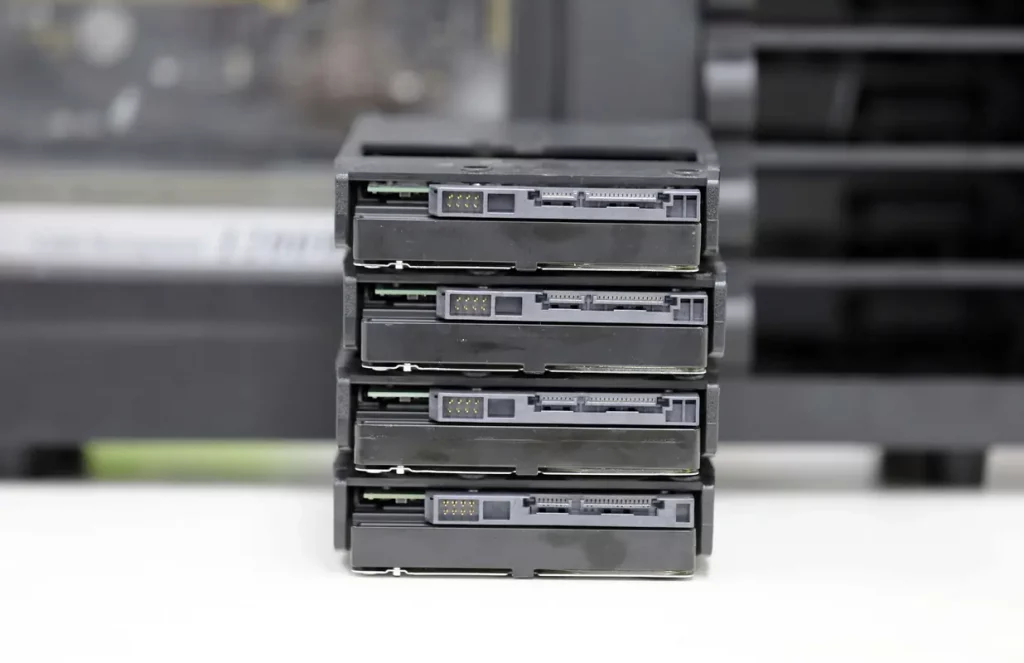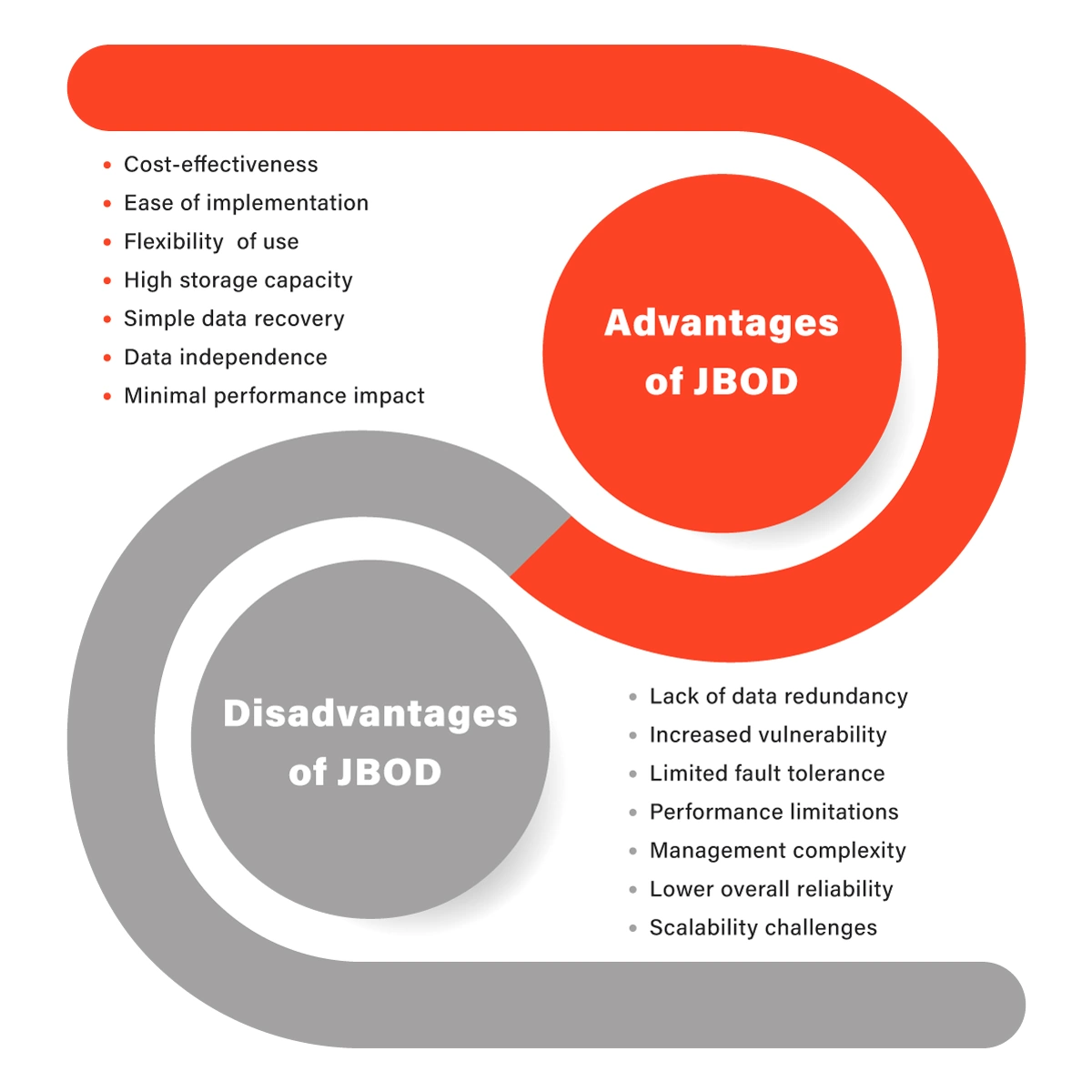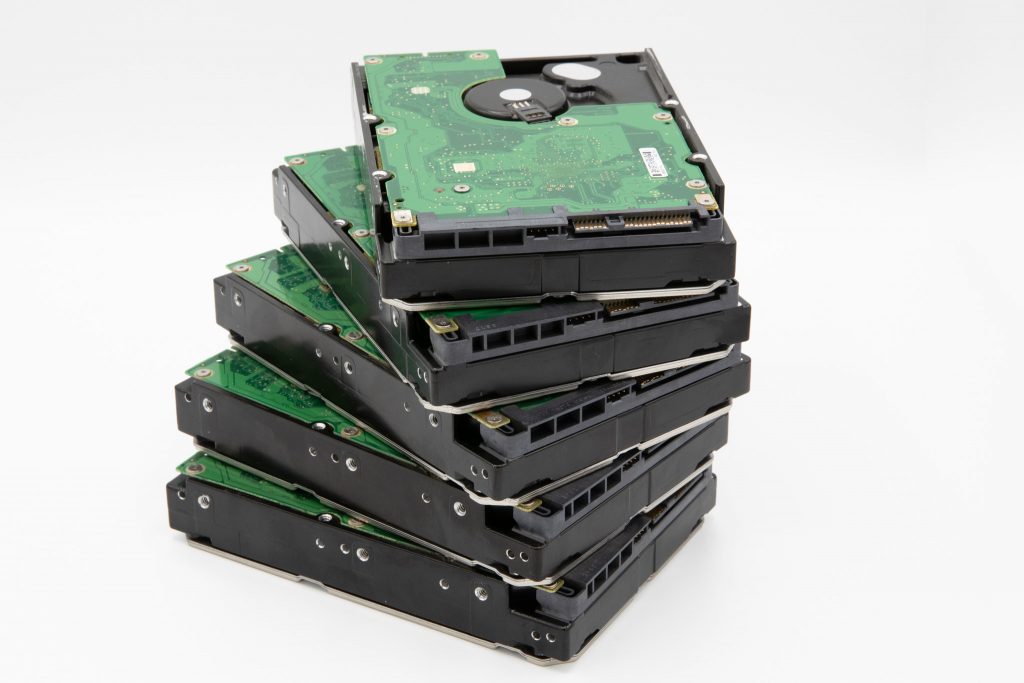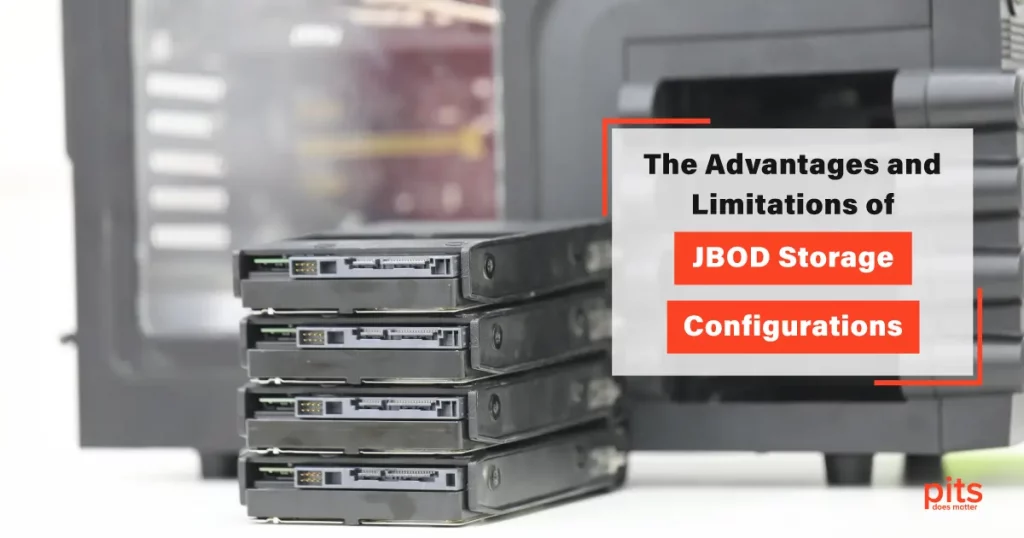In the world of data storage, there are numerous configurations available to meet the ever-increasing demand for larger capacities and higher performance. One such configuration is JBOD, which stands for “Just a Bunch Of Disks.” In this blog post, we will delve into the concept of JBOD, understand how it works, and explore its advantages and limitations compared to other storage configurations, particularly RAID.
Understanding JBOD
JBOD, as the name suggests, is a storage architecture that simply combines multiple disks into a single logical volume, treating them as a unified entity. It does not provide any data redundancy or fault tolerance. Each disk in a JBOD configuration operates independently, and data is stored sequentially across the disks. Unlike RAID arrays, JBOD does not implement data striping or mirroring techniques.
JBOD offers a cost-effective solution for expanding storage capacity in an existing system. It allows users to combine multiple disks of different sizes and brands into a single logical volume, presenting it as a single drive to the operating system. This approach eliminates the need for complex RAID controllers or software, making JBOD an attractive option for those seeking a simple storage expansion.

JBOD works by concatenating individual disks together, creating a continuous storage space. For example, if you have four 1TB disks in a JBOD configuration, the resulting logical volume will appear as a single 4TB drive. Data is stored sequentially across the disks, meaning that when one disk is full, the next disk is utilized. This makes JBOD hot swappable, as individual disks can be added or removed without affecting the overall system.
Comparing JBOD to RAID
While JBOD provides a straightforward and cost-effective solution for storage expansion, it lacks the data redundancy and fault tolerance offered by RAID configurations.
RAID (Redundant Array of Independent Disks) encompasses various levels, such as RAID 0, RAID 1, RAID 5, and more, each providing different combinations of performance, redundancy, and storage capacity.
RAID arrays distribute data across multiple disks, offering increased read and write speeds. In contrast, JBOD does not provide any striping or mirroring techniques. Therefore, JBOD may not be suitable for applications that require high-performance data access or critical data protection.

Advantages of JBOD
- Cost-Effective Expansion: One of the key advantages of JBOD is its cost-effectiveness. JBOD allows users to utilize their existing disk drives without the need for specialized hardware or software. This means that you can expand your storage capacity without significant additional investment, making it an attractive option for those on a budget.
- Flexibility and Scalability: JBOD offers flexibility in terms of storage configurations. It allows you to combine disks of different sizes, brands, or even different types (such as HDDs and SSDs) into a single logical volume. This flexibility enables you to optimize your storage setup based on your specific needs. Additionally, JBOD is a scalable solution, as you can easily add or remove disks as required, allowing for future expansion or reconfiguration.
- Hot Swappable Disks: JBOD configurations support hot swapping, which means that individual disks can be added or removed while the system is running. This feature offers convenience and flexibility in terms of storage maintenance and upgrades. It allows you to replace faulty disks or upgrade to larger capacity disks without shutting down the system or interrupting ongoing operations.
- Simplified Management: JBOD simplifies storage management and maintenance. Unlike more complex RAID configurations, JBOD does not require specialized controllers or software. This means that setting up and managing a JBOD system is relatively straightforward. With JBOD, you can avoid the complexity associated with RAID, making it an attractive option for users who prefer simplicity.

- Utilization of Existing Disks: JBOD allows you to make use of your existing disk drives, including those that might have been lying unused or replaced in other systems. By combining these disks into a JBOD configuration, you can maximize their value and extend their lifespan. This can be particularly advantageous in situations where you have a collection of mismatched or retired disks.
- No Performance Overhead: Unlike certain RAID configurations that introduce performance overhead due to data striping, mirroring, or parity calculations, JBOD does not impose any such performance penalties. Each disk in a JBOD setup operates independently, allowing for straightforward and efficient data access and storage operations. This can be advantageous for applications or workloads that prioritize raw speed over data redundancy.
Limitations of JBOD
- Lack of Data Redundancy: One of the significant limitations of JBOD is the absence of data redundancy. In a JBOD configuration, if one disk fails, the entire logical volume is at risk. Unlike RAID configurations that provide various levels of redundancy, such as mirroring or parity, JBOD does not have built-in mechanisms to protect against data loss. This limitation makes JBOD less suitable for applications that require high levels of data reliability and fault tolerance.
- Limited Fault Tolerance: Since JBOD does not offer data redundancy, the failure of a single disk can result in significant data loss. While RAID configurations provide fault tolerance by spreading data across multiple disks, JBOD lacks this capability. It’s important to have a robust backup and recovery strategy in place when using JBOD to mitigate the risks associated with disk failures.

- Performance Impact for Large Datasets: JBOD configurations may experience performance limitations when dealing with large datasets. Since data is stored sequentially across the disks without striping or other optimization techniques, read and write speeds may not be as efficient as with RAID configurations that offer data striping. This can be a concern for applications that require fast access to large volumes of data or perform intensive data processing.
- No Load Balancing: JBOD does not distribute data across disks based on load balancing algorithms like some RAID levels do. This means that if you have uneven data distribution or access patterns, certain disks may become more heavily utilized than others, potentially leading to performance bottlenecks or uneven wear on the disks.
- Limited Storage Capacity Expansion: While JBOD allows for cost-effective storage expansion, the maximum storage capacity is limited by the individual disk sizes in the configuration. Unlike RAID configurations, where you can combine disks of different sizes and create logical volumes with larger capacities, JBOD simply concatenates the disks, resulting in a total capacity equal to the sum of the individual disk sizes. If you require a large storage capacity, JBOD may not be the most efficient option.
- Absence of Advanced RAID Features: JBOD lacks the advanced features found in RAID configurations, such as automated data migration, automatic error detection, or the ability to rebuild data on failed disks. These features enhance the overall reliability and manageability of RAID systems but are absent in JBOD setups.
JBOD, or Just a Bunch of Disks, is a storage configuration that combines multiple disks into a single logical volume. While it offers cost-effective storage expansion and flexibility, it lacks the data redundancy and fault tolerance provided by RAID configurations. JBOD is suitable for non-critical data storage and applications that prioritize cost-efficiency over performance and data protection. When considering storage options, it is crucial to assess the specific needs of your system and weigh the advantages and limitations of JBOD against other configurations, such as RAID arrays, to make an informed decision.
Frequently Asked Questions
Can I add or remove disks from a JBOD configuration?
Yes, one of the advantages of JBOD is its support for hot-swappable disks. This means that you can add or remove individual disks from a JBOD configuration while the system is running, without the need to shut it down. Hot-swapping provides convenience and flexibility for storage maintenance, upgrades, or replacing faulty disks. However, it’s important to note that adding or removing disks does not provide data redundancy or automatic data migration like certain RAID levels do.
What are the limitations of JBOD compared to RAID?
JBOD has some limitations when compared to RAID configurations. One significant limitation is the absence of data redundancy, which means that if a disk fails in a JBOD configuration, the entire logical volume could be compromised, resulting in potential data loss. Additionally, JBOD may have performance constraints for large datasets since it does not provide data striping or other optimization techniques like certain RAID levels.
Can I mix different disk sizes or types in a JBOD configuration?
Yes, JBOD offers flexibility in terms of disk sizes and types. You can mix disks of different sizes, brands, or even different types, such as HDDs and SSDs, in a JBOD configuration. This flexibility allows you to optimize your storage setup based on your specific needs and make use of your existing disk drives.
What is JBOD and how does it differ from RAID?
JBOD stands for “Just a Bunch Of Disks,” which refers to a storage configuration that combines multiple disks into a single logical volume. Unlike RAID (Redundant Array of Independent Disks), JBOD does not provide data redundancy or fault tolerance. Each disk in a JBOD configuration operates independently, whereas RAID implements various levels with different combinations of performance, redundancy, and storage capacity.
What is the main difference between JBOD and RAID?
JBOD (Just a Bunch Of Disks) is a storage configuration that combines multiple disks into a single logical volume without providing data redundancy or fault tolerance. RAID (Redundant Array of Independent Disks), on the other hand, is a technology that uses multiple disks to provide various levels of data redundancy, performance optimization, and fault tolerance.
